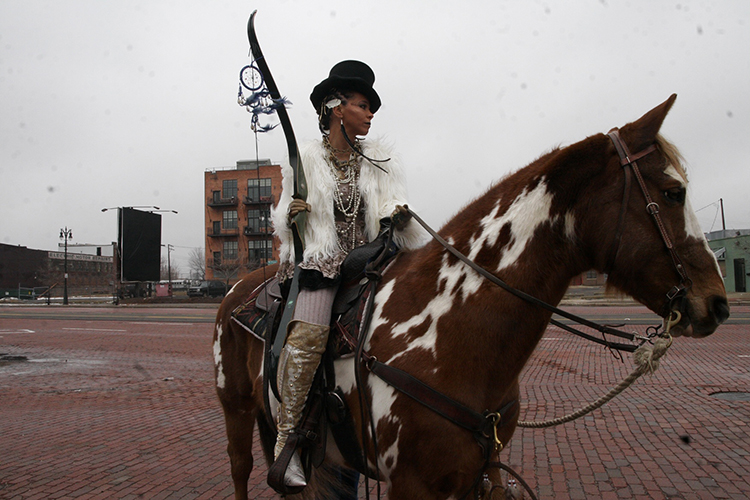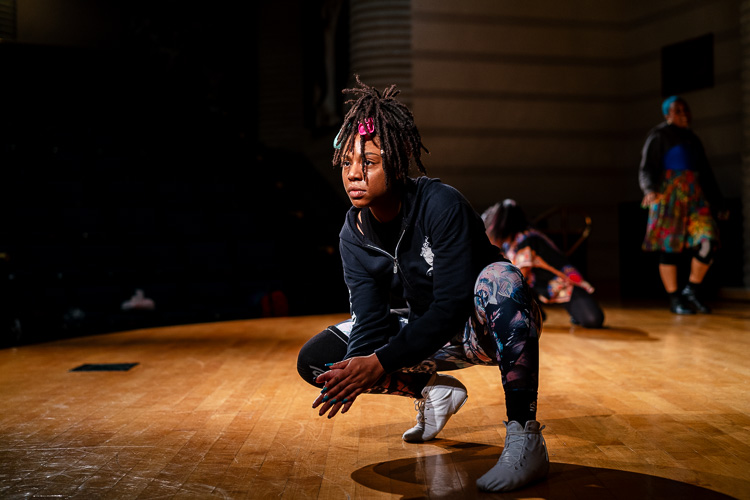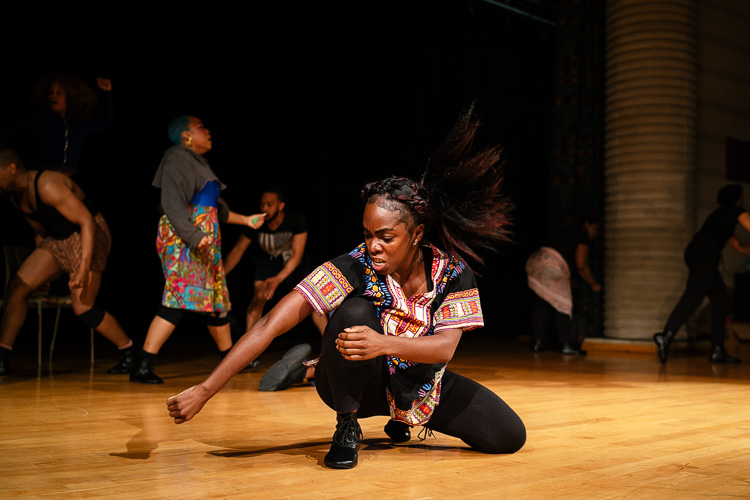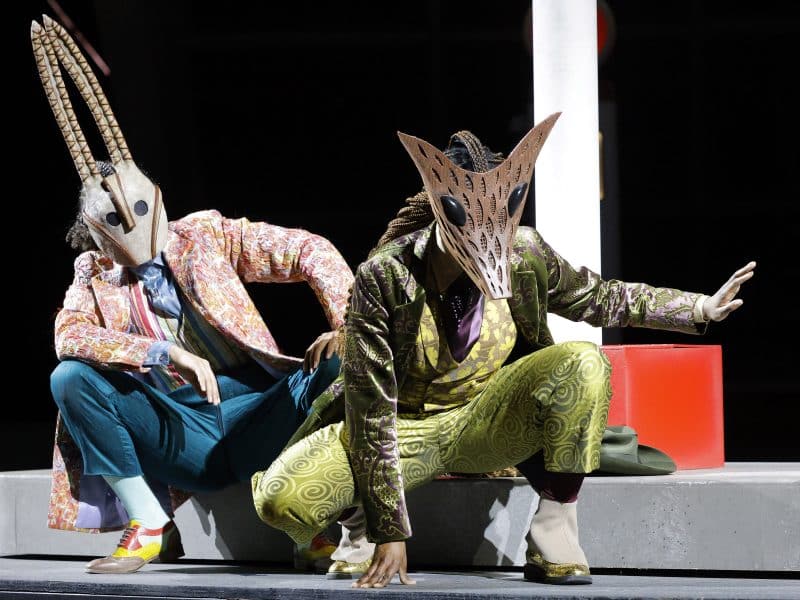jessica Care moore brings choreopoem ‘Salt City’ to Detroit
Poet jessica Care moore's choreopoem runs from June 13-16 at the Charles H. Wright Museum of African American History.
In the center of the room, dancers surround a warrior named Musa. His presence is demanding and pronounced, yet strong and gentle as he speaks of his people in Salt City.
“We are a sound. We are a pillar of a people … Combined light of these tunnels, you can taste us in the air.”
Through the twists of the dancers’ hips and bends of their bodies to the faint pulsating thump of a techno beat, you see the energy and connection between Salt, Musa’s daughter, and her lover Aingkhu, on their journey to the Electric Forest.
Across the floor is jessica Care moore, creator of “Salt City.” Her face beams as she watches the dancers glide around the stage putting movement to her words during a recent dress rehearsal of the production, which premieres on Thursday and runs until Sunday at the Charles H. Wright Museum of African American History.
Set in the year 3071, “Salt City,” is an Afrofuturistic, techno choreopoem taking place in the salt mines that currently run below Allen Park, Melvindale and Detroit’s west side.
“Knowing that I grew up on top of salt mines, I wanted to create fairytale about a brown girl who wasn’t right now, who was about the future,” says moore.
The “ballet,” as moore passionately refers to it, follows Salt, a young girl who goes on a journey of exploration, survival, and discovery of self while finding love along the way. Moore says she believes it’s important for Black people, especially Black girls, to see themselves in the “beautiful future.”
“I’m definitely Salt, and the father-daughter relationship written in there is very important to me,” says moore. “You don’t get to see a lot of brown girl coming-of-age stories where the father is a core figure in her life — I wanted that to be there.”
The choreopoem: ‘It’s what we do’

Inspired by Detroit’s techno and underground scene, moore began working on “Salt City” in 2015 at Spelman College in Atlanta. While “Salt City” is her most recent work with choreopoem, it is not her first. In 1996, she presented her first choreopoem “The Revolutions in the Ladies’ Room” with the Afrikan Poetry Theatre and Nuyorican Poets Café, both in New York City. Moore says she likes to explore more creative ways to bring her words and poetry to life beyond just speaking them.
“I was doing a lot of experimental work with dance and dancers and wanting to put my poetry out, the text alone was never enough,” says moore. “I was always thinking bigger, than just reading poems in a book store, it’s so much more than that to me.”
It was at Spelman that she brought on choreographer and director Aku Kadogo, chair of the Department of Theatre and Performance at Spelman College and former director of Wayne State University’s Black Theatre Program, to further develop the choreopoem. Kadogo is no stranger to the choreopoem genre; she was an original cast member of Ntazoke Shange’s “for colored girls who have considered suicide/when the rainbow is enuf,” a work credited with giving life to the genre.
“To me the choreopoem is something that we do in our culture; Ntazoke Shange coined the term, but we weren’t taught it — it’s what we do,” Kadogo says. “When we walk up and give each other dap, that is our living choreopoem.”
Shange was also a mentor to moore, who is seen as the heir to Shange’s legacy of the poetry-based performances.
In 2017 Moore received a Knight Arts Challenge for the techno-inspired dance and theater production.
Tony-nominated Marlies Yearby, Salt City’s choreographer and co-director alongside Kadogo, agrees that the choreopoem has always been a part of the African and Black American culture. Yearby explains that movement and dance are naturally used to enhance the words that are spoken.
“When you look at Africa, when they are telling a story in their culture, all of it embodies the music, the dance, the speaking, all at once,” Yearby says. “The body can contradict the words in the dance, the dance can be at harmony with the words and the dance can be in dialogue with the words.”
Multilayered messages

While “Salt City” may follow Salt as she discovers love, it is far more than the story of a girl and a boy. It touches on topics like gentrification and cultural erasure while exploring Afrofuturism.
A term coined by Mark Dery in his essay “Black to the Future,” Afrofuturism is used to describe the fusion of traditional elements of Black and African culture with techno and space influences. It’s a theme that is present in the music of Jimi Hendrix, George Clinton, and Janelle Monae; and most recently was captured on the silver screen in Marvel’s 2018 blockbuster, “Black Panther.” It’s also a theme that the “Salt City” cast has seemed to fully embrace and according to dance captain and Detroit native, Ta’Rajee Omar, Afrofuturism is as much the present as it is the future.
“[Afrofuturism] is using everything that we have created and put into the atmosphere, and using that to re-inform, to restore and to be innovative,” Omar says. “We’re reclaiming a space that is safe and righteous for us.”
While “Salt City’s” themes and messages may be multilayered, Detroit’s Miakaela Evans, who portrays the show’s lead character, Salt, wants attendees to leave realizing their own power and ability to grow.
“I want them to see that the power is within them and that they can afford whatever it is that they want,” Evans says. “You can grow within your spirit and travel within the realms to see your future to see your past, live in your present as if you are all of those things.”
“Salt City” runs from Thursday, June 13 through Saturday, June 15 at the Charles H. Wright Museum of African American History. For more information, go to www.thewright.org.








